Ann Rehabil Med.
2014 Jun;38(3):297-303. 10.5535/arm.2014.38.3.297.
Interhemispheric Modulation of Dual-Mode, Noninvasive Brain Stimulation on Motor Function
- Affiliations
-
- 1Department of Physical and Rehabilitation Medicine, Center for Prevention and Rehabilitation, Heart Vascular and Stroke Institute, Samsung Medical Center, Sungkyunkwan University School of Medicine, Seoul, Korea. yunkim@skku.edu
- 2Department of Rehabilitation Medicine, Pusan National University School of Medicine, Yangsan, Korea.
- 3Research Institute for Convergence of Biomedical Science and Technology, Pusan National University Yangsan Hospital, Yangsan, Korea.
- KMID: 2165745
- DOI: http://doi.org/10.5535/arm.2014.38.3.297
Abstract
OBJECTIVE
To investigate the effects of simultaneous, bihemispheric, dual-mode stimulation using repetitive transcranial magnetic stimulation (rTMS) and transcranial direct current stimulation (tDCS) on motor functions and cortical excitability in healthy individuals.
METHODS
Twenty-five healthy, right-handed volunteers (10 men, 15 women; mean age, 25.5 years) were enrolled. All participants received four randomly arranged, dual-mode, simultaneous stimulations under the following conditions: condition 1, high-frequency rTMS over the right primary motor cortex (M1) and sham tDCS over the left M1; condition 2, high-frequency rTMS over the right M1 and anodal tDCS over the left M1; condition 3, high-frequency rTMS over the right M1 and cathodal tDCS over the left M1; and condition 4, sham rTMS and sham tDCS. The cortical excitability of the right M1 and motor functions of the left hand were assessed before and after each simulation.
RESULTS
Motor evoked potential (MEP) amplitudes after stimulation were significantly higher than before stimulation, under the conditions 1 and 2. The MEP amplitude in condition 2 was higher than both conditions 3 and 4, while the MEP amplitude in condition 1 was higher than condition 4. The results of the Purdue Pegboard test and the box and block test showed significant improvement in conditions 1 and 2 after stimulation.
CONCLUSION
Simultaneous stimulation by anodal tDCS over the left M1 with high-frequency rTMS over the right M1 could produce interhemispheric modulation and homeostatic plasticity, which resulted in modulation of cortical excitability and motor functions.
Keyword
MeSH Terms
Figure
Cited by 1 articles
-
The Persisted Effects of Low-Frequency Repetitive Transcranial Magnetic Stimulation to Augment Task-Specific Induced Hand Recovery Following Subacute Stroke: Extended Study
Jarugool Tretriluxana, Jenjira Thanakamchokchai, Chutima Jalayondeja, Narawut Pakaprot, Suradej Tretriluxana
Ann Rehabil Med. 2018;42(6):777-787. doi: 10.5535/arm.2018.42.6.777.
Reference
-
1. Berardelli A, Inghilleri M, Rothwell JC, Romeo S, Curra A, Gilio F, et al. Facilitation of muscle evoked responses after repetitive cortical stimulation in man. Exp Brain Res. 1998; 122:79–84. PMID: 9772114.
Article2. Pascual-Leone A, Tormos JM, Keenan J, Tarazona F, Canete C, Catala MD. Study and modulation of human cortical excitability with transcranial magnetic stimulation. J Clin Neurophysiol. 1998; 15:333–343. PMID: 9736467.
Article3. Maeda F, Keenan JP, Tormos JM, Topka H, Pascual-Leone A. Modulation of corticospinal excitability by repetitive transcranial magnetic stimulation. Clin Neurophysiol. 2000; 111:800–805. PMID: 10802449.
Article4. Kim YH, You SH, Ko MH, Park JW, Lee KH, Jang SH, et al. Repetitive transcranial magnetic stimulation-induced corticomotor excitability and associated motor skill acquisition in chronic stroke. Stroke. 2006; 37:1471–1476. PMID: 16675743.
Article5. Nitsche MA, Cohen LG, Wassermann EM, Priori A, Lang N, Antal A, et al. Transcranial direct current stimulation: State of the art 2008. Brain Stimul. 2008; 1:206–223. PMID: 20633386.
Article6. Nitsche MA, Paulus W. Sustained excitability elevations induced by transcranial DC motor cortex stimulation in humans. Neurology. 2001; 57:1899–1901. PMID: 11723286.
Article7. Nitsche MA, Nitsche MS, Klein CC, Tergau F, Rothwell JC, Paulus W. Level of action of cathodal DC polarisation induced inhibition of the human motor cortex. Clin Neurophysiol. 2003; 114:600–604. PMID: 12686268.
Article8. Vines BW, Nair D, Schlaug G. Modulating activity in the motor cortex affects performance for the two hands differently depending upon which hemisphere is stimulated. Eur J Neurosci. 2008; 28:1667–1673. PMID: 18973584.
Article9. Vines BW, Nair DG, Schlaug G. Contralateral and ipsilateral motor effects after transcranial direct current stimulation. Neuroreport. 2006; 17:671–674. PMID: 16603933.
Article10. Netz J, Ziemann U, Homberg V. Hemispheric asymmetry of transcallosal inhibition in man. Exp Brain Res. 1995; 104:527–533. PMID: 7589304.
Article11. Gorsler A, Baumer T, Weiller C, Munchau A, Liepert J. Interhemispheric effects of high and low frequency rTMS in healthy humans. Clin Neurophysiol. 2003; 114:1800–1807. PMID: 14499741.
Article12. Murphy TH, Corbett D. Plasticity during stroke recovery: from synapse to behaviour. Nat Rev Neurosci. 2009; 10:861–872. PMID: 19888284.
Article13. Mordillo-Mateos L, Turpin-Fenoll L, Millan-Pascual J, Nunez-Perez N, Panyavin I, Gomez-Arguelles JM, et al. Effects of simultaneous bilateral tDCS of the human motor cortex. Brain Stimul. 2012; 5:214–222. PMID: 21782545.
Article14. Nitsche MA, Roth A, Kuo MF, Fischer AK, Liebetanz D, Lang N, et al. Timing-dependent modulation of associative plasticity by general network excitability in the human motor cortex. J Neurosci. 2007; 27:3807–3812. PMID: 17409245.
Article15. Rossini PM, Barker AT, Berardelli A, Caramia MD, Caruso G, Cracco RQ, et al. Non-invasive electrical and magnetic stimulation of the brain, spinal cord and roots: basic principles and procedures for routine clinical application. Report of an IFCN committee. Electroencephalogr Clin Neurophysiol. 1994; 91:79–92. PMID: 7519144.
Article16. Priori A, Berardelli A, Rona S, Accornero N, Manfredi M. Polarization of the human motor cortex through the scalp. Neuroreport. 1998; 9:2257–2260. PMID: 9694210.
Article17. Wade DT. Measuring arm impairment and disability after stroke. Int Disabil Stud. 1989; 11:89–92. PMID: 2698395.
Article18. Boissy P, Bourbonnais D, Carlotti MM, Gravel D, Arsenault BA. Maximal grip force in chronic stroke subjects and its relationship to global upper extremity function. Clin Rehabil. 1999; 13:354–362. PMID: 10460123.
Article19. Vines BW, Cerruti C, Schlaug G. Dual-hemisphere tDCS facilitates greater improvements for healthy subjects' non-dominant hand compared to uni-hemisphere stimulation. BMC Neurosci. 2008; 9:103. PMID: 18957075.
Article20. Ferbert A, Priori A, Rothwell JC, Day BL, Colebatch JG, Marsden CD. Interhemispheric inhibition of the human motor cortex. J Physiol. 1992; 453:525–546. PMID: 1464843.
Article21. Siebner HR, Lang N, Rizzo V, Nitsche MA, Paulus W, Lemon RN, et al. Preconditioning of low-frequency repetitive transcranial magnetic stimulation with transcranial direct current stimulation: evidence for homeostatic plasticity in the human motor cortex. J Neurosci. 2004; 24:3379–3385. PMID: 15056717.
Article
- Full Text Links
- Actions
-
Cited
- CITED
-
- Close
- Share
- Similar articles
-
- Enhancing Motor Learning with Transcranial Direct Current Stimulation
- Novel Approaches of Non-Invasive Stimulation Techniques to Motor Rehabilitation Following Stroke: A Review
- Mechanism of Neurolasticity after Brain Injury and Neurorehabilitation
- Rewiring the Lesioned Brain: Electrical Stimulation for Post-Stroke Motor Restoration
- Clinical Applications of Transcranial Direct Current Stimulation in Neurological Disorders




